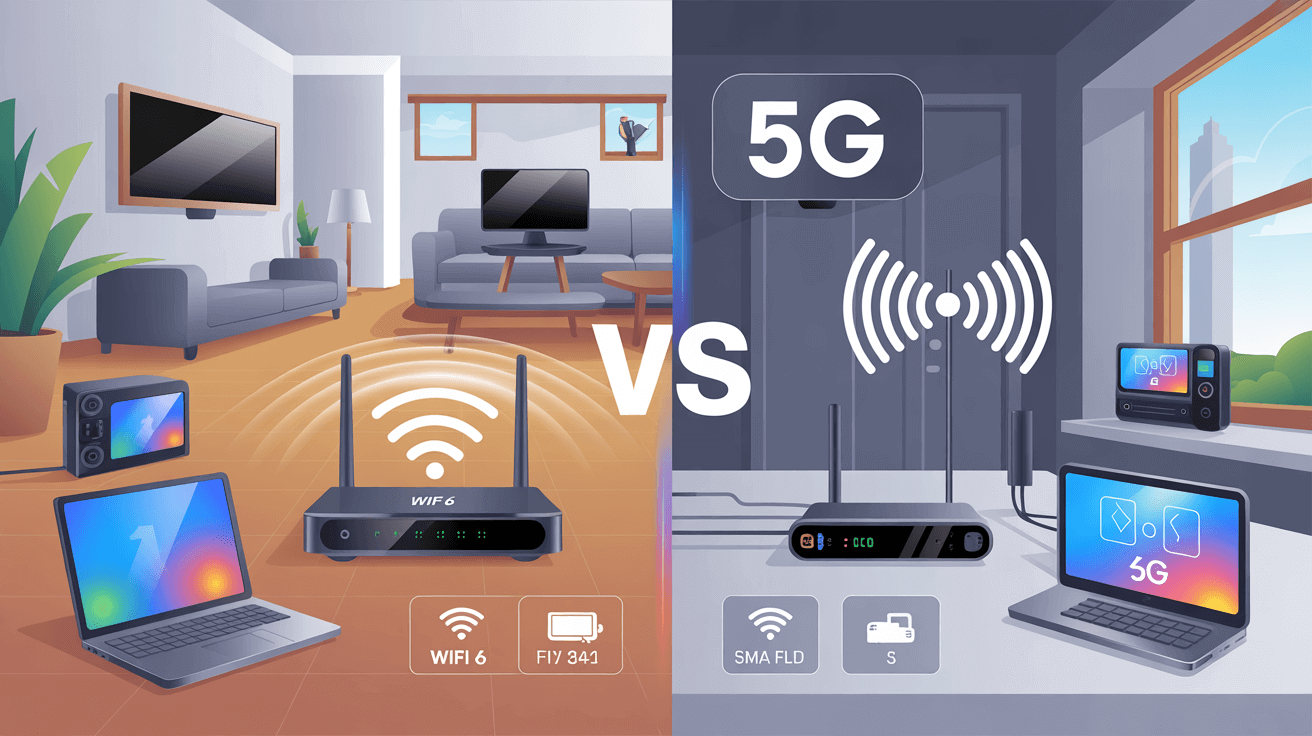Setting up the perfect home wireless network isn’t just about speed anymore. With both 5G home internet and WiFi 6 routers hitting mainstream markets, you’re probably wondering which technology deserves your hard-earned cash. I’ve spent weeks diving into real-world performance data, and the answer might surprise you.
The truth is, your home wireless network choice depends more on your specific needs than flashy marketing promises. While 5G can theoretically hit 10 Gbps speeds, WiFi 6 maxes out at 9.6 Gbps. But here’s what really matters for your daily internet experience.
What Makes These Technologies Different?
WiFi 6: Your Indoor Champion
WiFi 6, also known as 802.11ax, is a wireless standard defined by IEEE that transforms how your devices connect inside your home. Unlike previous generations, WiFi 6 uses advanced technologies like OFDMA and MU-MIMO to handle multiple devices simultaneously without the usual slowdowns.
Wi-Fi 6 has more speed to go around, which can be split across an entire network of devices, meaning improved speeds on your network when you have several devices connected. This matters because the average household has continually increased the number of devices it connects to Wi-Fi over the years.
5G: The Wireless Internet Revolution
Meanwhile, 5G home internet works completely differently. 5G home internet plans run on a fixed wireless connection that sends and receives radio waves on a 5G network. Think of it as replacing your cable or fiber connection entirely – no more waiting for technician visits or dealing with buried cables.
5G home internet commonly gives you speeds around 100–300 Mbps. But 5G internet speeds can reach up to 1,000 Mbps, depending on the plan and quality of cell service in your area.
Speed Performance: The Real Numbers That Matter
Let’s cut through the marketing hype and look at what you’ll actually experience in your home wireless network setup.
WiFi 6 Speed Reality
WiFi 6 can deliver a maximum throughput of 9.6 Gbps, but real-world testing shows different results. In practical scenarios, Wi-Fi 6 can significantly outperform Wi-Fi 5, with throughputs of about 920 Mbps under optimal conditions.
However, distance matters tremendously. Your home wireless network performance drops as you move away from your router. Most users see speeds between 200-600 Mbps depending on their location within the house and the number of connected devices.
5G Home Internet Performance
5G home internet commonly gives you speeds around 100–300 Mbps in real-world usage. While that’s lower than WiFi 6’s peak performance, it’s often more consistent throughout your home since the 5G gateway doesn’t suffer from the same distance limitations as traditional routers.
The catch? 5G can be a little unpredictable—your 5G signal can be impacted by a range of factors that don’t come into play with wired internet types. Weather, building materials, and nearby cell tower congestion can all affect your connection.
Coverage and Reliability: Where Each Technology Shines
WiFi 6 Coverage Strengths
WiFi 6 excels in high-density device environments. WiFi 6 also improves capacity and device support. The features I have talked about can support up to 8 devices simultaneously. It was 4 devices with WiFi 5. Additionally, individual wireless routers and access points can support up to approximately 250 connected devices.
Your home wireless network with WiFi 6 provides rock-solid indoor coverage, especially when you invest in mesh systems or multiple access points.
5G Coverage Reality
5G is seen as a solution for wide-area coverage and high-speed mobility, but availability remains the biggest hurdle. Major metropolitan areas like Los Angeles, Chicago, Minneapolis, and New York offer 5G home internet access, though coverage continues expanding rapidly.
Once you have good 5G signal strength, the consistency can actually surpass traditional broadband options.
Cost Analysis: What You’ll Actually Pay
WiFi 6 Investment
Building a solid home wireless network with WiFi 6 requires an upfront router investment. For the past few years, Wi-Fi 6 routers have been the sweet spot for value for price-sensitive consumers — it’s easy to find them for around $100 or less.
Budget options include:
- TP-Link Archer AX55 is a great budget router that comes with a 2-year warranty and built-in security software at around $130
- TP-Link Archer AX55 is the best we’ve tested in that price range for mid-range needs
Premium mesh systems can cost $800-2,000, but they transform your entire home wireless network experience.
5G Monthly Costs
5G home internet operates on monthly subscription models:
- T-Mobile offers plans starting at $35/month with AutoPay and any T-Mobile voice line
- Verizon 5G Home Internet plans start at $35/mo
- Total Wireless Home Internet plan’s base price costs $60 per month, with additional discounts available
The gateway device is typically included, but you’re locked into monthly payments forever.
Device Compatibility and Future-Proofing
WiFi 6 Device Support
Most devices manufactured after 2020 support WiFi 6, and backward compatibility ensures older gadgets still work. Your home wireless network benefits immediately from upgrading, even with mixed device generations.
The technology is mature and widely supported across smartphones, laptops, smart TVs, and IoT devices.
5G Device Requirements
5G home internet works with any WiFi-enabled device since the gateway creates a traditional WiFi network. However, you need to first cancel any existing monthly subscription you have to current internet services and ensure 5G coverage at your address.
Practical Use Cases: When Each Technology Wins
Choose WiFi 6 When:
Your home wireless network needs center around indoor performance and device density. WiFi 6 is better suited for indoor wireless coverage. It offers increased support for IoT-connected devices and high-density wireless service.
WiFi 6 makes sense if you:
- Have reliable cable or fiber internet already
- Need to support 20+ smart home devices
- Prioritize consistent indoor coverage
- Want a one-time investment
Choose 5G Home Internet When:
5G is ideal for outdoor use cases, autonomous vehicle support, and mobile backhaul, but it also works well for homes lacking good wired internet options.
Consider 5G if you:
- Live in areas with limited cable/fiber options
- Want plug-and-play setup without technician visits
- Need internet service that works during power outages (with backup power)
- Prefer predictable monthly costs
Latency and Gaming Performance
For gamers and video callers, latency matters as much as speed. 5G home internet is a relatively new type of internet service that gets you Wi-Fi access over a fixed wireless connection, and while it offers less latency and a more reliable connection than satellite, it typically can’t match the low latency of wired connections.
WiFi 6 routers connected to quality fiber internet usually provide the best gaming experience for your home wireless network. However, 5G’s improving latency performance makes it increasingly viable for most gaming scenarios.
The Future: Why You Might Want Both
Here’s something most reviews miss: you don’t have to choose. If 5G home internet is available in your area, you can pair it with the latest and greatest Wi-Fi solutions to connect your home to a faster and more efficient Wi-Fi network.
Many tech-savvy users are combining 5G home internet as their ISP with high-end WiFi 6 routers for the ultimate home wireless network setup. This approach gives you the flexibility of wireless internet service plus the performance benefits of cutting-edge router technology.
Rather than replacing each other, 5G and WiFi will coexist and work together. As both technologies mature, we’ll see more integrated solutions that automatically switch between networks for optimal performance.
Security Considerations
Both technologies take security seriously, but with different approaches. WiFi 6 devices are required to support WPA3 security. WPA3, or WiFi Protected Access Version 3, is currently the best WiFi security standard.
5G also uses several authentication types, which include 5G Authentication and Key Agreement, Extensible Authentication Protocol-AKA and EAP-Transport Layer Security to bolster 5G network security.
For your home wireless network, both options provide enterprise-grade security when properly configured.
Bottom Line: Which Should You Choose?
After testing both technologies extensively, here’s my honest recommendation:
Go with WiFi 6 if you have reliable wired internet (cable/fiber) and want to maximize indoor performance. The upfront investment pays off through years of consistent service, and you maintain control over your network setup.
Choose 5G home internet if you’re tired of dealing with traditional ISPs, live in an area with poor wired options, or value the simplicity of plug-and-play internet service. Just ensure you have strong 5G coverage first.
Consider both if you’re building the ultimate home wireless network setup and want redundancy plus cutting-edge performance.
The wireless connectivity landscape continues evolving rapidly. As both technologies mature and prices drop, the gap between them narrows. What matters most is choosing the solution that fits your specific home environment, budget, and usage patterns.
Your home wireless network deserves technology that works reliably every day, not just impressive benchmark numbers. Both 5G and WiFi 6 can deliver that reliability when properly implemented – the key is matching the right technology to your unique situation.
Meta Description: “Compare 5G vs WiFi 6 for your home wireless network. Real speed tests, costs, and setup guides to choose the best connectivity solution for your house.”








